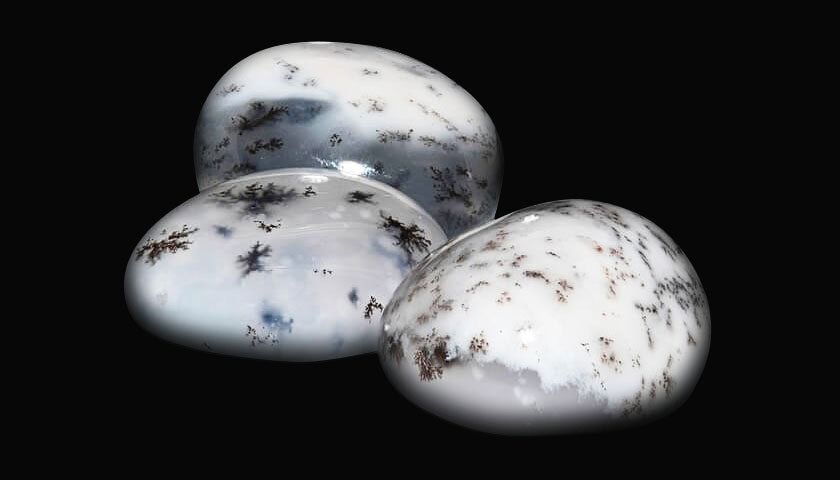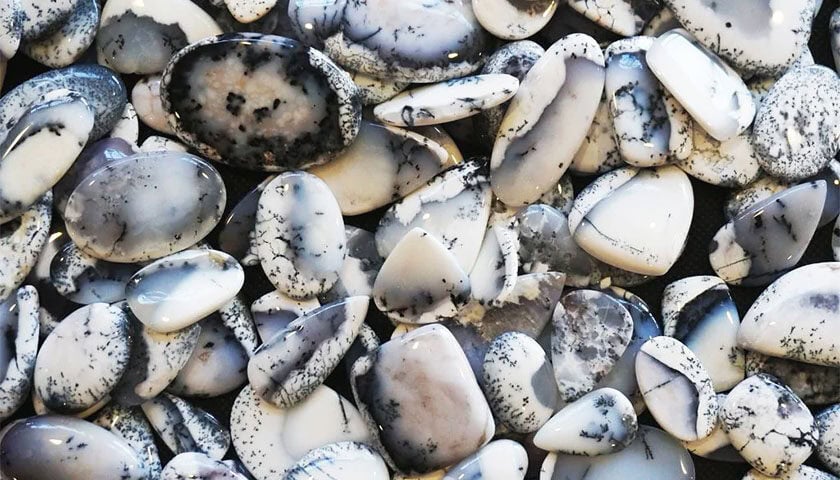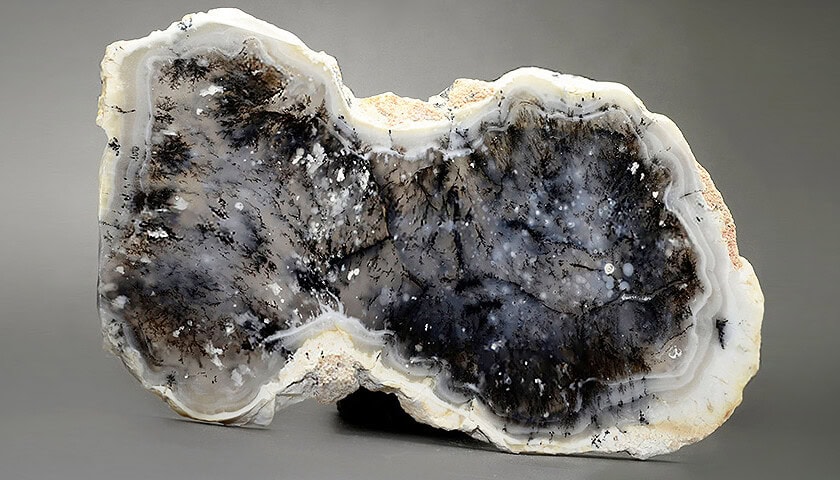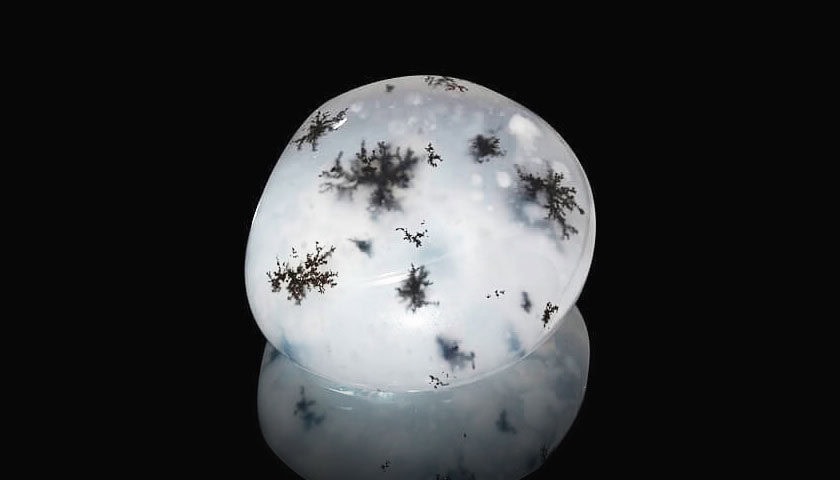Article Highlights
Dendritic opal is a highly potent stone with unusual yet interesting properties. Also known as Moss Opal or Merlinite, dendritic opal is a particularly magical and attractive stone that has been used over the years by healers and jewels. Its unusual traits aside, dendritic opal is moderate to extremely rare and is mined in New Mexico, Australia, and other mines. Here is everything you need to know about dendritic opal (moss opal).
Dendritic Opal Meaning and History

The term “dendritic” refers to an object that possesses a branch-like form or appearance. Dendritic opals have an opaque milky white base, often broken up with high-contrast iron and manganese inclusions. Such inclusions are sporadic, leading to imprints that resemble trees and branches.
In addition, its moss opal alias originates from the fact that most dendritic opal samples are densely populated with inclusions, leading them to resemble moss. Generally, moss opal is classified as Common opal, and it lacks the color plays common in Precious opal.
Historically, dendritic opals have existed for centuries. Within its system lies potent organic energy that appears to have existed for the longest time. During the middle ages, opals were believed to possess magical power.

Dendritic opal was used as a symbol of power and status in different civilizations. It was adopted as a mystical healing gemstone and is still being used by astrological healers. It was infused in various architectural masterpieces and displayed as art.
Much like other opals, dendritic opals share different mythologies and origin stories. One of the common Greek mythologies pointing to opals’ origin is that opals are tears shed by Zeus after claiming victory during the battle against the Titans.
Before its rediscovery in the 19th century, dendritic opal was highly precious. The stone’s rediscovery led to scientific knowledge that classified the stone and partly limited its value.
Dendritic Opal Geological Properties
Opals are hydrated silica minerals comprised of microscopic spheres combined with water and silica. They are also classified into Common and Precious opals, further classified into individual opals types depending on color and composition.

Dendritic opal is classified under common opal. Common opaque is typically opaque with different color variations such as pink, orange, brown, yellow, and white. However, all these opals may have dendrite formations.
Dendritic opal is an opal type that is dark in color and has a tabular or dendritic pattern at the base. Even though it is commonly found in black and white, the gemstone may have different shades ranging from dark grey to bluish-black. Its composition includes manganese.
Dendritic opals form when water-rich seeping mineral solutions containing iron and manganese flow along naturally appearing fissures, fractures, and bedding planes. The solution creates unique dendrites varying in shape and size of the ratio of the concentration of opal to the mineral solution of the hydroxides and manganese oxides present.
The opals have an amorphous crystal system and a SiO2·nH2O composition. Dendritic opals measure 5-6 on the Mohs Scale of hardness. In addition, they have an uneven and conchoidal fracture and a white streak. They also have a subvitreous to wavy luster and a 2.15 specific gravity. Transparency varies from translucent to opaque.
| Category | Mineraloid |
| Formula (repeating unit) | Hydrated silica. SiO2·nH2O |
| Crystal system | Amorphous |
| Crystal habit | Irregular veins, in masses, in nodules |
| Fracture | Conchoidal to uneven |
| Mohs scale hardness | 5.5 – 6 |
| Luster | Subvitreous to waxy |
| Diaphaneity | opaque, translucent, transparent |
| Specific gravity | 2.15+0.08 |
| −0.90 | |
| Density | 2.09 g/cm3 |
| Polish luster | Vitreous to resinous |
| Optical properties | Single refractive, often anomalous double refractive due to strain |
| Refractive index | 1.450+0.020 |
| −0.080 | |
| Diagnostic features | darkening upon heating |
| Solubility | hot saltwater, bases, methanol, humic acid, hydrofluoric acid |
Healing Properties and Benefits

Dendritic opals are healing stones just like other common and precious opals. They possess different physical, emotional, mental, and spiritual healing properties. Check out some of the key healing properties and benefits of dendritic opals.
Physical Healing
Astrology healers believe opals are good for one’s physical well-being. Dendritic opals possess energies and properties that are beneficial to your circulatory systems. It is widely used to ease symptoms of blood disorders and reduce chronic dizziness.
Additionally, dendritic opals can regulate and stabilize your insulin production and improve your kidney’s toxin-flushing capabilities. Healers use the moss opal to help reduce inflammation around your body and also alleviate serious digestive issues. It helps to put your body in touch with your mind, which helps in general well-being.
Emotional Healing
Dendritic opal thrives heavily on emotional healing. It effectively acts as a self-reflection mirror, helping you look deeper into your emotions and how they affect your existence. Most people find it almost virtually impossible to identify their independent needs.
During such moments of self-doubt, it is vital to look deep within yourself and establish your emotions accordingly. Dendritic opal helps you gain the full perspective you require to self-reflect. The stone also encourages you to identify, validate, and reorganize your innermost emotions. As such, you can better grasp your true identity and how external factors affect you.
Dendritic opal is especially ideal for individuals who are at a crossroads. Instead of postponing your decisions till the last minute, you can weigh all your options and choose accordingly.
The stone also helps you to be more accepting of others. It opens your heart and mind to the possibility of making friends just like Aegirine. Its vibrations help you see the good and beauty in others. On a related note, the stone helps you communicate well with others. This encourages harmony and understanding between you and your new friends.
Unsurprisingly, the stone does wonders for your relationships and love life. Dendritic opal’s energies help you focus on your personality to improve your relationships with others. It helps you organize yourself to balance your time appropriately between your personal and love life.
Consequently, you become emotionally aware and intelligent, which is ideal in different settings. Emotional intelligence helps you relate accordingly with your colleagues, friends, family, strangers, kids, and lovers.
Spiritual Healing
The self-reflection you gain from dendritic opal is also important for your spiritual welfare. The ability to look deep inwards can influence your spirit positively and make you more connected to the energies surrounding you.
Consequently, you gain a better perspective and see things in a different light. Spiritual healers revere the stone’s ability to strengthen your intuition and help you connect with the higher realm. The dendritic opal acts as a spiritual satellite. This means it invites divine messages and keeps you connected to your guardian angel. Consequently, you will stay informed and make sound judgment calls about your experiences.
The stone focuses on synchronization. An uninterrupted flow of your life force energy is vital to keep you happy and healthy. Therefore, the stone helps to synchronize your body, mind, and spirit into one functioning state.
Dendritic opals highlight the darkness, thus giving users the courage to comprehend, embrace, and infuse different life lessons. This helps to guide you to a greater connection and unity of your entire divine being and existence. Generally, moss opals grant you the strength to look deep inside and fix your fears and worries that belittle the warrior in you.
Dendritic Opal and Chakra
The dendritic opal is linked to the third eye chakra. However, it may have some influence over all your primary chakras. Located on your forehead, your third eye chakra is the most affected stone being the center of intuition. It is also the center of wisdom and aims for a greater state of consciousness. Dendritic stone is ideal for tuning in to one’s solar plexus chakra, which governs your ego.
Zodiac Connection
Moss opal is popular with individuals born in October. As such, it may be considered an October birthstone. The stone is connected to the zodiac sign Libra. However, its benefits can be shared and enjoyed wide across the different zodiac signs.
Common Uses of the Dendritic Opal
Dendritic opal is used as a healing stone. By wearing it close to the heart, it helps to heal your emotional struggles. It is believed to contain several physical, emotional, mental, and spiritual healing benefits. Astrologers and healers use the stone to derive such healing benefits.
Additionally, dendritic opal is used in jewelry. Though hard to cut, moss opal makes a fine piece of jewelry due to its appealing appearance.
How to Care for the Dendritic Opal

Moss opal is soft and easy to chip, dry out, or discolor. However, caring for these stones is not entirely impossible. Ensure you know which type of opal you have before taking any care measures. Triplet and doublet dendritic opals have different layers and are also infused with glue.
You should store such altered opals in tight plastic bags with a damp cloth or cotton piece. Ensure the stones don’t touch any wet surfaces since moisture may affect the stone’s coloration and the glue.
A cut and polished solid dendritic opal should be stored and sealed in a secure plastic bag with a damp cloth or cotton piece. Store the bag in a room with a dehumidifier to prevent dehydration. Such a stone is susceptible to fading or drying if exposed to intense heat or stays dry for too long.
Avoid using cleaning detergents or chemicals when cleaning dendritic opals. Wipe the dust off with a dry cloth. However, to polish them well, ensure you gently wipe them with a soft and damp cloth.
Bottom Line
Dendritic opal, also known as moss opal, is a variety of common opal with unique patterns on its base. Though not so rare, it is still a valuable type of opal with opal-like properties. However, it lacks the vibrant display and play of colors present in other opal types. However, it is still appreciated and used for its healing properties, whether physically, emotionally, or spiritually.

